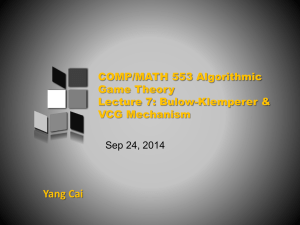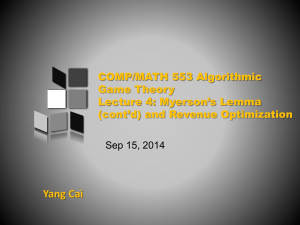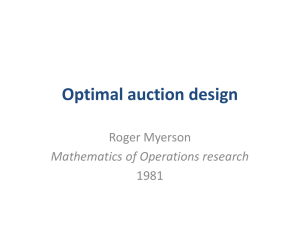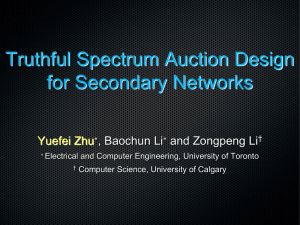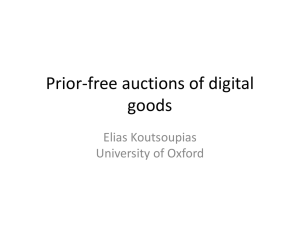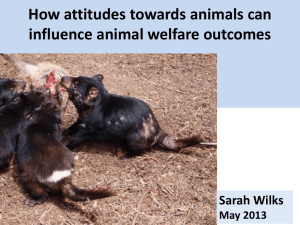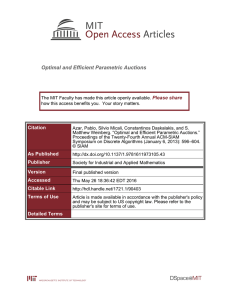Slides
advertisement
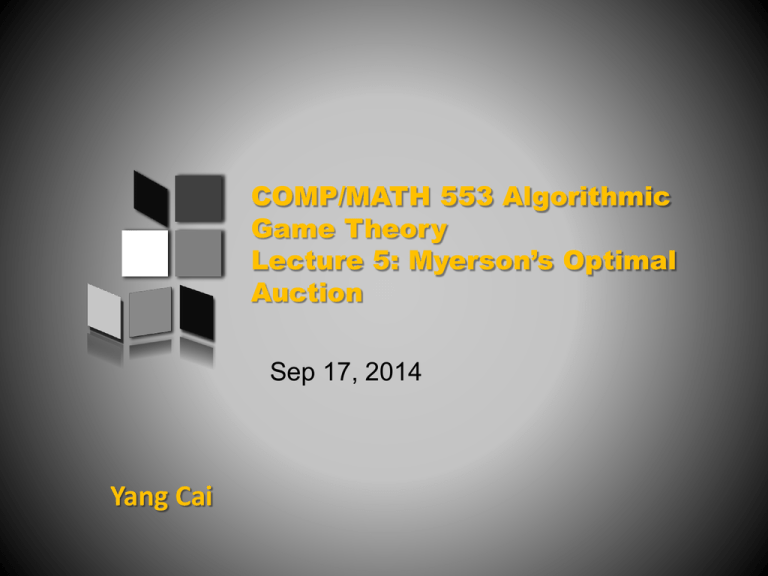
COMP/MATH 553 Algorithmic
Game Theory
Lecture 5: Myerson’s Optimal
Auction
Sep 17, 2014
Yang Cai
An overview of today’s class
Expected Revenue = Expected Virtual Welfare
2 Uniform [0,1] Bidders Example
Optimal Auction
Revelation Principle Recap
S1(b1 )
b1
b2
. . . . . .
S1( )
S2( )
. . . . . .
S2(b2 )
bn
S n( )
Sn(bn)
Original Mechanism M
x(s1(b1), s2(b2),...,sn(bn))
New Mechanism M’
Revenue Maximization
Bayesian Analysis Model
A single-dimensional environment, e.g. single-item
The private valuation vi of participant i is assumed to be drawn from a distribution
Fi with density function fi with support contained in [0,vmax].
We assume that the distributions F1, . . . , Fn are independent (not necessarily
identical).
In practice, these distributions are typically derived from data, such as bids in
past auctions.
The distributions F1 , . . . , Fn are known in advance to the mechanism designer.
The realizations v1, . . . , vn of bidders’ valuations are private, as usual.
Revenue-Optimal Auctions
[Myerson ’81
]
Single-dimensional settings
Simple Revenue-Optimal auction
What do we mean by optimal?
Step 0: What types of mechanism do we need to consider? In other words, optimal
amongst what mechanisms?
Consider the set of mechanisms that have a dominant strategy equilibrium.
Want to find the one whose revenue at the dominant strategy equilibrium is the
highest.
A large set of mechanisms. How can we handle it?
Revelation Principle comes to rescue! We only need to consider the directrevelation DSIC mechanisms!
Expected Revenue = Expected
Virtual Welfare
Revenue = Virtual Welfare
[Myerson ’81
] For any single-dimensional
environment.
Let F= F1 × F2 × ... × Fn be the joint value distribution, and
(x,p) be a DSIC mechanism. The expected revenue of this
mechanism
Ev~F[Σi pi(v)]=Ev~F[Σi xi(v) φi (vi)],
where φi (vi) := vi- (1-Fi(vi))/fi(vi) is called bidder i’s virtual
value (fi is the density function for Fi).
Myerson’s OPTIMAL
AUCTION
Two Bidders + One Item
Two bidders’ values are drawn i.i.d. from U[0,1].
Vickrey with reserve at ½
• If the highest bidder is lower than ½, no one wins.
• If the highest bidder is at least ½, he wins the item and pay
max{1/2, the other bidder’s bid}.
Revenue 5/12.
This is optimal. WHY???
Two Bidders + One Item
Virtual value for v: φ(v)= v- (1-F(v))/f(v) = v- (1-v)/1= 2v-1
Optimize expected revenue = Optimize expected virtual welfare!!!
Should optimize virtual welfare on every bid profile.
For any bid profile (v1,v2), what allocation rule optimizes virtual welfare?
(φ(v1), φ(v2))=(2v1-1, 2v2-1).
•
If max{v1,v2} ≥ 1/2, give the item to the highest bidder
•
Otherwise, φ(v1), φ(v2) < 0. Should not give it to either of the two.
This allocation rule is monotone.
Revenue-optimal Single-item Auction
Find the monotone allocation rule that optimizes expected virtual welfare.
Forget about monotonicity for a while. What allocation rule optimizes
expected virtual welfare?
Should optimize virtual welfare on every bid profile v.
- max Σi xi(v) φi (vi). , s.t Σi xi(v) ≤ 1
Call this Virtual Welfare-Maximizing Rule.
Revenue-optimal Single-item Auction
Is the Virtual Welfare-Maximizing Rule monotone?
Depends on the distribution.
Definition 1 (Regular Distributions): A single-dimensional distribution F is
regular if the corresponding virtual value function v- (1-F(v))/f(v) is nondecreasing.
Definition 2 (Monotone Hazard Rate (MHR)): A single-dimensional
distribution F has Monotone Hazard Rate, if (1-F(v))/f(v) is non-increasing.
Revenue-optimal Single-item Auction
What distributions are in these classes?
-
MHR: uniform, exponential and Gaussian distributions and many more.
-
Regular: MHR and Power-law...
-
Irregular: Multi-modal or distributions with very heavy tails.
When all the Fi’s are regular, the Virtual Welfare-Maximizing Rule is
monotone!
Two Extensions Myerson did (we won’t teach)
What if the distributions are irregular?
-
Point-wise optimizing virtual welfare is not monotone.
-
Need to find the allocation rule that maximizes expected virtual welfare among all monotone
ones. Looks hard...
-
This can be done by “ironing” the virtual value functions to make them monotone, and at the
same time preserving the virtual welfare.
We restrict ourselves to DSIC mechanisms
-
Myerson’s auction is optimal even amongst a much larger set of “Bayesian incentive
compatible (BIC)” (essentially the largest set) mechanisms.
-
For example, this means first-price auction (at equilibrium) can’t generate more revenue than
Myerson’s auction.
Won’t cover them in class.
- Section 3.3.5 in “Mechanism Design and Approximation”, book draft by Jason Hartline.
- “Optimal auction design”, the original paper by Roger Myerson.
